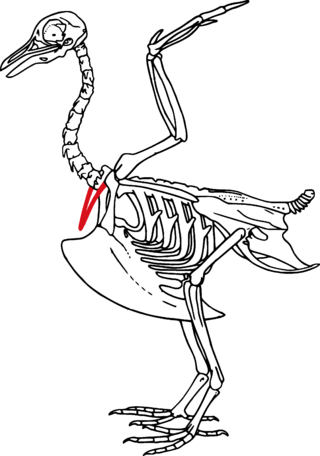
The furcula or wishbone is a forked bone found in most birds and some species of non-avian dinosaurs, and is formed by the fusion of the two clavicles. In birds, its primary function is in the strengthening of the thoracic skeleton to withstand the rigors of flight.
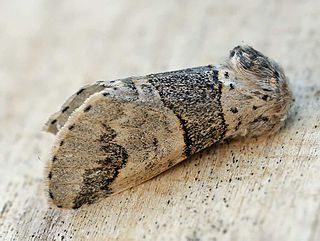
The poplar kitten is a species of moth in the family Notodontidae. The species was first described by Nikolaus Joseph Brahm in 1787. They are found throughout Europe and in North Africa, Mongolia, Kazakhstan and Xinjiang.
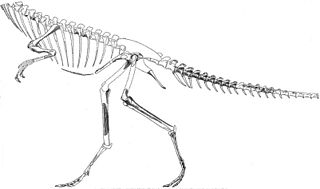
Segisaurus is a genus of small coelophysid theropod dinosaur, that measured approximately 1 metre in length. The only known specimen was discovered in early Jurassic strata in Tsegi Canyon, Arizona, for which it was named. Segisaurus is the only dinosaur to have ever been excavated from the area.

The furcula, or furca It is a forked, tail-like appendage. It is present in most species of springtails, and in them it is attached ventrally to the fourth abdominal segment. The organ most often is present in species of Collembola that lives in the upper soil layers where it is used for jumping to avoid predators. While at rest, it is retracted under the abdomen and held there by a structure variously called the retinaculum or hamula, which in turn is located beneath the third abdominal segment. When the furcula escapes from retinaculum, it swings downwards and hits the substrate, propelling the springtail into the air. The animal does not use this mechanism for ordinary locomotion, but only for escaping from predators or severe stress.

Furcula furcula, the sallow kitten, is a moth from the family Notodontidae. It was first described by the Swedish entomologist Carl Alexander Clerck in 1759 from a specimen found in Sweden.
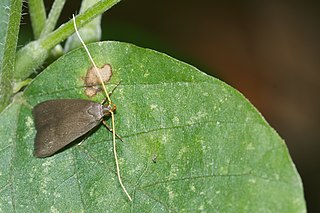
The Lecithocerinae are a subfamily of small moths in the family Lecithoceridae. They are found worldwide, but most species occur in South Asia. The subfamily is characterized by the male genitalia with a bridge-like structure connecting the tegumen and the valva, and the uncus almost always is vestigial with two lobes at the dorsal base, only exceptionally united into a broad plate, but never as a thorn or spine.
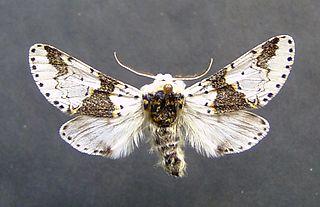
Furcula bicuspis, the alder kitten, is a moth of the family Notodontidae. The species was first described by Moritz Balthasar Borkhausen in 1790. It is found in most of the Palearctic realm.

Homaloxestis is a genus of moths in the family Lecithoceridae. The genus was erected by Edward Meyrick in 1910.

Furcula is a genus of moths of the family Notodontidae. The genus was described by Jean-Baptiste Lamarck in 1816.
Homaloxestis baibaraensis is a moth in the family Lecithoceridae first described by Kyu-Tek Park in 1999. It is found in Taiwan.
Homaloxestis australis is a moth in the family Lecithoceridae. It was described by Kyu-Tek Park in 2004. It is found in Thailand, northern Vietnam and the Philippines.
Homaloxestis multidentalis is a moth in the family Lecithoceridae. It was described by Kyu-Tek Park in 2004. It is found in Thailand.
Homaloxestis pumilis is a moth in the family Lecithoceridae. It was described by Kyu-Tek Park in 2004. It is found in Thailand.
Homaloxestis saitoi is a moth in the family Lecithoceridae. It was described by Kyu-Tek Park in 2004. It is found in Thailand.
Homaloxestis grabia is a moth in the family Lecithoceridae. It was described by Chun-Sheng Wu and Kyu-Tek Park in 1999. It is found in Sri Lanka.
Homaloxestis lacerta is a moth in the family Lecithoceridae. It was described by Chun-Sheng Wu and Kyu-Tek Park in 1999. It is found in Sri Lanka.
Homaloxestis plocamandra is a moth in the family Lecithoceridae. It was described by Edward Meyrick in 1907. It is found in Nepal, India, Bhutan, northern Vietnam, Thailand and the Philippines (Luzon).
Homaloxestis aganacma is a moth in the family Lecithoceridae. It was described by Alexey Diakonoff in 1968. It is found on Luzon in the Philippines.
Homaloxestis luzonensis is a moth in the family Lecithoceridae. It was described by Kyu-Tek Park and Bong-Kyu Byun in 2007. It is found on Luzon in the Philippines.
Homaloxestis quadralis is a moth in the family Lecithoceridae. It was described by Kyu-Tek Park and Bong-Kyu Byun in 2007. It is found in Palawan in the Philippines.







